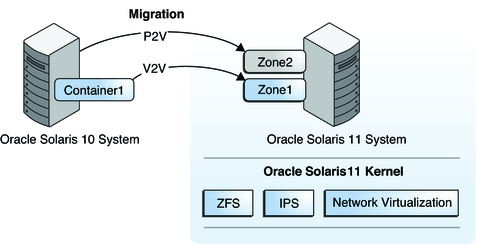| Skip Navigation Links | |
| Exit Print View | |

|
Oracle Solaris 11.1 Administration: Oracle Solaris Zones, Oracle Solaris 10 Zones, and Resource Management Oracle Solaris 11.1 Information Library |
| Skip Navigation Links | |
| Exit Print View | |

|
Oracle Solaris 11.1 Administration: Oracle Solaris Zones, Oracle Solaris 10 Zones, and Resource Management Oracle Solaris 11.1 Information Library |
Part I Oracle Solaris Resource Management
1. Introduction to Resource Management
2. Projects and Tasks (Overview)
3. Administering Projects and Tasks
4. Extended Accounting (Overview)
5. Administering Extended Accounting (Tasks)
6. Resource Controls (Overview)
7. Administering Resource Controls (Tasks)
8. Fair Share Scheduler (Overview)
9. Administering the Fair Share Scheduler (Tasks)
10. Physical Memory Control Using the Resource Capping Daemon (Overview)
11. Administering the Resource Capping Daemon (Tasks)
13. Creating and Administering Resource Pools (Tasks)
14. Resource Management Configuration Example
15. Introduction to Oracle Solaris Zones
16. Non-Global Zone Configuration (Overview)
17. Planning and Configuring Non-Global Zones (Tasks)
18. About Installing, Shutting Down, Halting, Uninstalling, and Cloning Non-Global Zones (Overview)
19. Installing, Booting, Shutting Down, Halting, Uninstalling, and Cloning Non-Global Zones (Tasks)
20. Non-Global Zone Login (Overview)
21. Logging In to Non-Global Zones (Tasks)
22. About Zone Migrations and the zonep2vchk Tool
23. Migrating Oracle Solaris Systems and Migrating Non-Global Zones (Tasks)
24. About Automatic Installation and Packages on an Oracle Solaris 11.1 System With Zones Installed
25. Oracle Solaris Zones Administration (Overview)
26. Administering Oracle Solaris Zones (Tasks)
27. Configuring and Administering Immutable Zones
28. Troubleshooting Miscellaneous Oracle Solaris Zones Problems
Part III Oracle Solaris 10 Zones
29. Introduction to Oracle Solaris 10 Zones
SVR4 Packaging and Patching in Oracle Solaris 10 Zones
About Using Packaging and Patching in solaris10 Branded Zones
About Performing Package and Patch Operations Remotely
Non-Global Zones as NFS Clients
About Oracle Solaris 10 Zones in This Release
Networking in Oracle Solaris 10 Zones
Networking Components That Are not Supported
Networking Features That Are Different
If native Non-Global Zones Are Installed
30. Assessing an Oracle Solaris 10 System and Creating an Archive
31. (Optional) Migrating an Oracle Solaris 10 native Non-Global Zone Into an Oracle Solaris 10 Zone
32. Configuring the solaris10 Branded Zone
33. Installing the solaris10 Branded Zone
The solaris10 branded zone, described in the solaris10(5) man page, is a complete runtime environment for Oracle Solaris 10 applications on SPARC and x86 machines running the Oracle Solaris 10 9/10 operating system or later released update. If you are running an Oracle Solaris 10 release earlier than Oracle Solaris 10 9/10, it is possible to use the earlier update release if you first install the kernel patch 142909-17 (SPARC) or 142910-17 (x86/x64), or later version, on the original system. You must install the patch before you create the archive that will be used to install the zone. It is the kernel patch of the release that is the prerequisite for migration to Oracle Solaris 10 Zones, not the full Oracle Solaris 10 9/10 or later release. The software download site for patches is My Oracle Support. Click on the "Patches & Updates" tab. On that site, you can view the download instructions and download the images. Contact your support provider for additional information regarding patches.
Non-global zones running within a single global zone instance are supported on all architectures that the Oracle Solaris 11.1 release has defined as supported platforms.
The brand includes the tools required to install an Oracle Solaris 10 system image into a non-global zone. You cannot install a solaris10 brand zone directly from Oracle Solaris 10 media. A physical-to-virtual (P2V) capability is used to directly migrate an existing system into a non-global zone on a target system. The zonep2vchk tool is used to generate information needed for the P2V process and to output a template zonecfg command file for use on the target system. The utility creates a zone that matches the source system's configuration. On a source Oracle Solaris 10 1/13 system, the utility /usr/sbin/zonep2vchk is included in the release. To use the utility on earlier versions of Oracle Solaris 10, download the unbundled package from Oracle Technology Network (OTN) at http://www.oracle.com/technetwork/server-storage/solaris10/downloads.
The brand also supports the tools used to migrate an Oracle Solaris 10 native zone into a solaris10 brand non-global zone. The virtual-to-virtual (V2V) process for migrating an Oracle Solaris 10 native non-global zone into a solaris10 branded zone supports the same archive formats as P2V. See Chapter 31, (Optional) Migrating an Oracle Solaris 10 native Non-Global Zone Into an Oracle Solaris 10 Zone for more information.
Figure 29-1 Oracle Solaris 10 Containers Transition to Oracle Solaris 10 Zones
